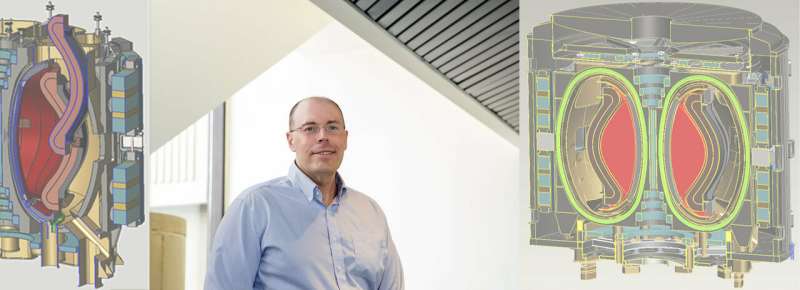Speeding the development of fusion power to create unlimited energy on Earth

Can tokamak fusion facilities, the most widely used devices for harvesting on Earth the fusion reactions that power the sun and stars, be developed more quickly to produce safe, clean, and virtually limitless energy for generating electricity? Physicist Jon Menard of the U.S. Department of Energy's (DOE) Princeton Plasma Physics Laboratory (PPPL) has examined that question in a detailed look at the concept of a compact tokamak equipped with high temperature superconducting (HTS) magnets. Such magnets can produce higher magnetic fields—necessary to produce and sustain fusion reactions—than would otherwise be possible in a compact facility.
Menard first presented the paper, now published in Philosophical Transactions of the Royal Society A, to a Royal Society workshop in London that explored accelerating the development of tokamak-produced fusion power with compact tokamaks. "This is the first paper that quantitatively documents how the new superconductors can interplay with the high pressure that compact tokamaks produce to influence how tokamaks are optimized in the future," Menard said. "What we tried to develop were some simple models that capture important aspects of an integrated design."
"Very significant" findings
The findings are "very significant," said Steve Cowley, director of PPPL. Cowley noted that "Jon's arguments in this and the previous paper have been very influential in the recent National Academies of Sciences report," which calls for a U.S. program to develop a compact fusion pilot plant to generate electricity at the lowest possible cost. "Jon has really outlined the technical aspects for much smaller tokamaks using high-temperature magnets," Cowley said.
Compact tokamaks, which can include spherical facilities such as the National Spherical Torus Experiment-Upgrade (NSTX-U) that is under repair at PPPL and the Mega Ampere Spherical Tokamak (MAST) in Britain, provide some advantageous features. The devices, shaped like cored apples rather than doughnut-like conventional tokamaks, can produce high-pressure plasmas that are essential for fusion reactions with relatively low and cost-effective magnetic fields.
Such reactions fuse light elements in the form of plasma—the hot, charged state of matter composed of free electrons and atomic nuclei—to release energy. Scientists seek to replicate this process and essentially create a star on Earth to generate abundant electricity for homes, farms, and industries around the world. Fusion could last millions of years with little risk and without generating greenhouse gases.
Extends previous examination
Menard's study extends his previous examination of a spherical design that could develop materials and components for a fusion reactor and serve as a pilot plant to produce electric power. The current paper provides a detailed analysis of the complex tradeoffs that future experiments will need to explore when it comes to integrating compact tokamaks with HTS magnets. "We realize that there's no single innovation that can be counted on to lead to some breakthrough for making devices more compact or economical," Menard said. "You have to look at an entire integrated system to know if you are getting benefits from higher magnetic fields."
The paper focuses key issues on the size of the hole, defined as the "aspect ratio," in the center of the tokamak that holds and shapes the plasma. In spherical tokamaks, this hole can be half the size of the hole in conventional tokamaks, corresponding to the cored apple-like shape of the compact design. While physicists believe that lower aspect ratios can improve plasma stability and plasma confinement, "we won't know on the confinement side until we run experiments on the NSXT-U and the MAST upgrades," Menard said.
Lower aspect ratios provide an attractive setting for HTS magnets, whose high current density can produce the strong magnetic fields that fusion requires inside the relatively narrow space of a compact tokamak. However, superconducting magnets need thick shielding for protection from neutron bombardment damage and heating, leaving scant room for a transformer to induce current in the plasma to complete the twisting field when the device size is reduced. For lower aspect ratio designs, scientists would thus have to develop new techniques to produce some or all of the initial plasma current.
200-to-300 megawatts of electric power
Sustaining the plasma to generate the 200-to-300 megawatts of electric power the paper examines would also require higher confinement than standard tokamak operating regimes typically achieve. Such power production could lead to challenging fluxes of fusion neutrons that would limit the estimated lifetime of the HTS magnets to one-to-two years of full-power operation. Thicker shielding could substantially increase that lifetime but would also lower the delivery of fusion power.
Major development will in fact be needed for HTS magnets, which have not yet been built to scale. "It will probably take years to put together a model of the essential elements of magnet size requirements and related factors as a function of aspect ratio," Menard said.
The bottom line, he said, is that the lower aspect ratio "is really worth investigating based on these results." The potential benefits of lower ratios, he noted, include the production of fusion power density—the crucial output of fusion power per volume of plasma—that exceeds the output for conventional aspect ratios. "Fusion needs to become more attractive," Menard said, "so it's important to assess the benefits of lower aspect ratios and what the tradeoffs are."
More information: J. E. Menard, Compact steady-state tokamak performance dependence on magnet and core physics limits, Philosophical Transactions of the Royal Society A: Mathematical, Physical and Engineering Sciences (2019). DOI: 10.1098/rsta.2017.0440
Journal information: Philosophical Transactions of the Royal Society A
Provided by Princeton Plasma Physics Laboratory





















